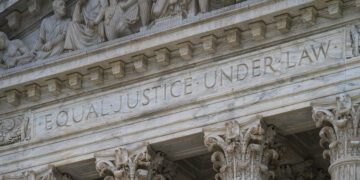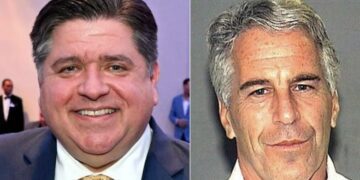By John F. Di Leo -
I cheered 30 years ago, when the Russians tore down statues of Lenin and Stalin.
And I cheered 20 years ago, when Iraqis tore down statues of Saddam Hussein.
I took me a long time to realize it, but… I was wrong.
Now, I’m not saying there was any good in these particular people. There wasn’t. They were off-the-charts malevolent. But some of those statues could have performed a public service, as reminders of past errors, and warnings that such errors must not be repeated.
In retrospect, perhaps it might have been better for the people of those countries to leave them up… perhaps to move them, but not to destroy them after all.
Imagine a ring of museum-quality displays around a statue of a dictator… the plaques beneath them changed to catalog the real biographies of these villains. The walls or signs surrounding them – professional signs, museum quality – would list their crimes, naming their purges and other tyrannies.
Picture these statues of Lenin and Stalin, surrounded by the charges that Nuremberg-style war trials would have convicted them of, had there been such a chance. One recounting the Stalin's dekulakization program. One telling of the vicious slaughter of the Tsar and his royal family. One listing the gulags. One explaining the trains to Siberia. Educational signs, filled with numbers, and photos, and details about the millions of innocents they killed, so that, at least in that city, no future generation would ever forget their evils.
But that’s not what happened, is it? The newly-freed public – understandably furious at the government that had oppressed them for so long – just tore down the statues, to act out their newfound liberty, to show the world that, at long last, they were finally free.
And we Americans thought it was a good idea at the time. (in the case of Iraq, it was our own soldiers who helped tear down Saddam’s huge new statue. Given the chance to destroy such a symbol of autocracy, who could resist?)
But look at these countries today. Many of the people of these countries have already forgotten the crimes of their recent statist leaders.
Just a single generation later, too many of the young people of these countries don't even know about their past governments' crimes. Imagine how bad it will be when everyone with personal memory of them has passed on.
In George Santayana’s most famous quote: “Those who cannot remember the past are condemned to repeat it.” Wise advice, and relevant here, more so than we might have expected. Here, living in a nation of heavily-subsidized public education, we shouldn’t be at risk of forgetting the past, but we are.
We in the United States spent 45 years absolutely terrified of nuclear war with the Soviet Union. Stalin, Malenkov, Khrushchev, Brezhnev, Andropov, Chernenko, and finally Gorbachev – as time marched on, we watched as different faces shared the same evil eyes, and we wondered if this new face would be the one to push the button.
How many of today’s children – there or here – know the fear that their parents and grandparents lived through during that long Cold War? How many understand the lethal power that socialist leaders have – on not only their own country, but on others as well?
Statues in Civilization
Like many other countries, the United States celebrates our history with statues.
Since we don’t have dictators, our statues are a more diverse mix… writers and politicians, generals and saints, explorers and artists. Scattered across our country, we have beautiful, expensive statuary, in public parks and inside government buildings, in front of museums and office buildings, even masterfully carved into the rock on the sides of mountains.
They are works of art, as well as reminders of our history and civilization.
An educated population can admire the statue of Louis Armstrong at St Louis Airport, or of Dean Martin at the Las Vegas Country Club, even if they’ve never heard them sing. An educated population can appreciate the beauty of Michelangelo’s pietas even if they aren’t Christian, the Venus de Milo even if they’re not pagan, a bronze Buddha without being a Buddhist.
Statues should be a teachable moment… a recollection of where we came from, a visual representation to help us remember our past.
When I see a statue of Theodore Roosevelt, I don’t feel compelled to agree with everything he did – his contention with Congress, his trust-busting policies, his leftist causes late in life. When I see his statues, it’s like clicking on a tab on the browser in my memory; I remember his career, both the good and the bad, the wonderful biographies and history books he wrote. His statue reminds me of where we have been, and gives me a personal gut check, with the question, "Am I doing my part, in helping America be what it should be?"
As a Federalist, I don’t like Tom Jefferson… but his statues remind me of both his wartime successes – the Declaration of Independence and standing up to the Barbary pirates – and his wartime failures – his dysfunction as a governor and his inability to comprehend the evil of the French Revolution. His statue at the Jefferson Memorial, surrounded by his greatest quotes, is inspirational; it reminds us that even so deeply flawed a person can accomplish incredible things.
When we see a statue of Napoleon – like the bust in my home office that I inherited from my father; it sits beside me as I write – we don’t think only of his wars, we remember both the positives and the negatives of his administration. He is inspirational, in that he appeared when France had truly gone to Hell for ten long and bloody years. Napoleon alone regained control from the Paris Mob, brought back order and the rule of law to a once-great nation. His Napoleonic Code reformed a feudal legal system; his decision to dump France’s massive geographical holdings in North America enabled American expansion as the Louisiana Purchase. Was he a hero, a role model for a modern American? Perhaps not. But his statues remind us of the march of history and of our critical place in that path.
What Are Statues For?
When we look at an image – whether the content in a book or the two-dimensional view of a portrait, or the three-dimensional view that the current obsession with statues calls to mind – the educated viewer can see both the good and the bad. With an educated populace, that image provides a public service by bringing our education to life, a visual aid that pulls what we learned in school, years ago, out of our past and into our present.
For Republicans watching today’s clamor to remove the statues of the Confederacy, we are tempted to chuckle because it Is so outside our experience. We are watching an internecine rivalry acting itself out in the DNC.
Think of it: crowds of Democrats, frothing at the mouth as they demand the removal of a fellow Democrat's statue, in a city ruled by Democrats since the dawn of time. This hatred of today's Democrats for yesterday's Democrats is just a family quarrel among the Democratic Party, the home of slavery, Indian suppression, the Japanese interment camps, Jim Crow, and so many other oppressive pockmarks on American history, all committed by the Democratic Party on its fellow man.
But this irony is lost on a generation lacking in education – they don't know that their favorite candidates are the descendants of the civil war generals they're tearing down.
And recent events have shown that in truth, the few puppet-masters really responsible for the attacks know this already.
We can understand an attack on Democrat Civil War generals. They were rebels, after all, who fought against the United States of America. Their statues really don’t belong at state capitols and county seats, and never did. You don’t see a statue of George Washington or Guy Fawkes in front of England’s Parliament, do you?
But the modern Left has bigger things in mind than just getting rid of reminders of the Civil War, the war that Democrats fought in an effort to expand slavery in America, and that Republicans fought in an effort to restrict and eventually end it.
Look who else they are pulling down, these days. They pressure a museum to remove a statue of Teddy Roosevelt, first president of the progressive era. They attack Columbus, an Italian explorer who worked for Spain. They attack Winston Churchill, the British prime minister who rallied the European opposition to Hitler. They attack Francis Scott Key, the author of the Star Spangled Banner. They attack Nathaniel Rochester, a Revolutionary War figure who founded the capital city of New York.
This isn’t about slavery, and never was. It’s not about police brutality or economic inequality.
This is about completing the effort that’s been in place for generations, to dumb down our educational system and remove knowledge of our history from the American public.
Ever since our Founding, an understanding of where we came from has been a critical element of understanding how to continue to move forward. We must know our history to know what works and what doesn’t, to understand the risks inherent in all public policy, both domestic and foreign.
But wisdom in the electorate is the enemy of the statist. Those who want power for power’s sake – those who want to rule us rather than help us remain free – do not benefit from an educated electorate that remembers Hitler and Mao, Stalin and Castro. So they tell us that true socialism has never been tried. They tell us that our own history is evil, and they rewrite the textbooks to press this lie on our children, generation after generation.
We must not relent. America is on a brink – far past it, in fact – and we need a course correction, in order to regain our position at the head of Western Civilization.
What to do about the statues? Sure, some should be moved. Democrats who rebelled against the USA shouldn’t sit in front of a state capitol building in a place of honor.
But destroying public property (and private too, of course) must never be allowed. These vandals must be punished with the full force of the law.
In some cases, yes, demand that the cities put up signs – fair signs, objective signs, stating both their accomplishments and their shames, where relevant, as in the case of the confederates. Don't bury the truth; use it as a teachable moment.
But also, see this for what it is. The recent attacks on non-confederate figures have opened everyone’s eyes to the truth of what’s going on. Antifa and Black Lives Matter are focused on destroying and remaking our civilization. This isn't political exaggeration; their own manifests announce it proudly. They have used a few cases of police brutality to light the spark, but this rebellion has nothing to do with police brutality.
This episode has revealed the modern Left for what it is: a fully-marxist movement, hoping to take advantage of an anxious moment to remake America into a the next domino in the goal of international statism.
More than ever, this should reveal the need for real, rigorous history class in our schools, and for the historical markers – statues, portraits, books and films – that tell the truth of our heritage and enable us to make our electoral decisions in an informed light.
There is a reason this is all happening in an election year.
Copyright 2020 John F. Di Leo
John F. Di Leo is a Chicagoland-based international trade professional, writer and actor. His column has been published in Illinois Review since 2009.
Don’t miss an article! Use the free tool in the margin to sign up for Illinois Review’s free email notification service, so you always know when IR publishes new content!







